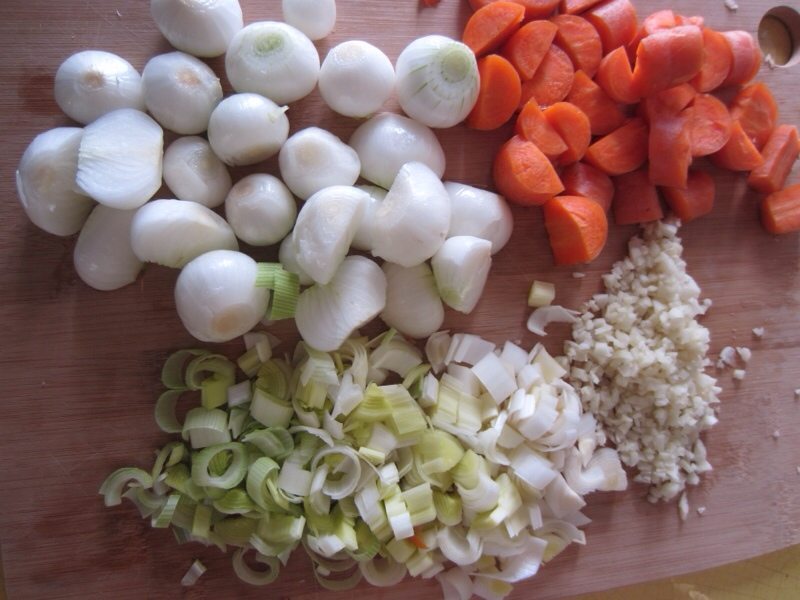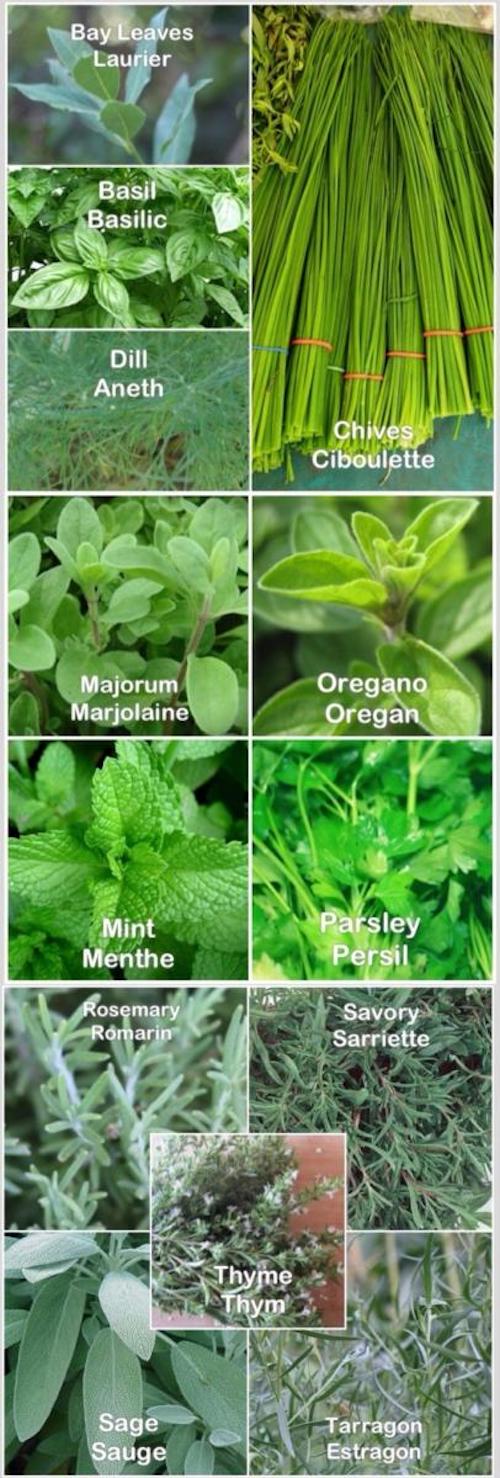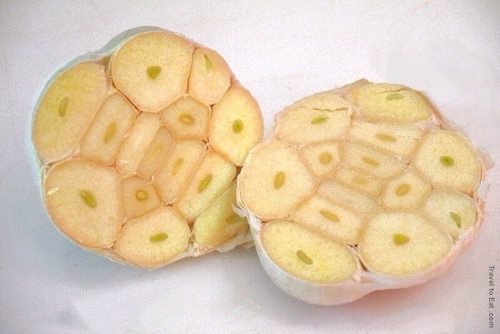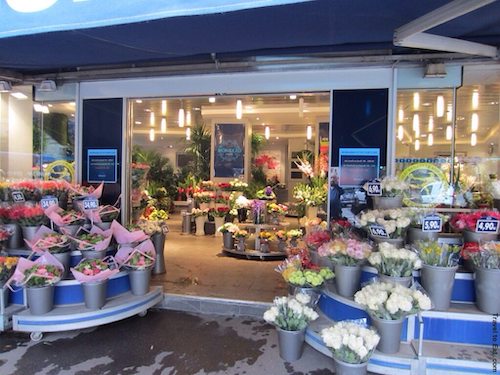
To all of my readers who eat or cook French food, I provide this handy list of French names of different types of food and preparations. The above picture has nothing to do with food but it is a typical and beautiful Paris flower store, and I like the picture.
Herbs (Herbes)
Bay Leaf: Laurier
Basil: Basilic
Chives: Ciboulette
Dill: Aneth
Majorum: Majolaine
Mint: Menthe
Oregano: Oregan
Parsley: Persil
Rosemary: Romarin
Sage: Sauge
Savory: Sarriette
Tarragon: Estrogon
Thyme: Thym
Black Pepper: Poivre Noir
Salt: Sel
In France they don’t use a lot of dried herbs, in the stores they have a very abbreviated selection of herbs and spices. The exception is Herbes de Provence which is a mixture of aromatic dried French herbs including thyme, rosemary, bay leaf, and savory. Savory is not seen often in American stores, it is used most often in cooking beans, but also in stews and marinades. It is interesting to note that this herb was was used extensively by the Romans to flavor their food. I got this huge bunch of thyme at the famers market which I took home and put in a vase. The sweet aroma filled my small kitchen. Thyme is used to make a “Bouquet Garni” to prepare soup, stock, and various stews, including traditional coq a vin which is what I did with it.
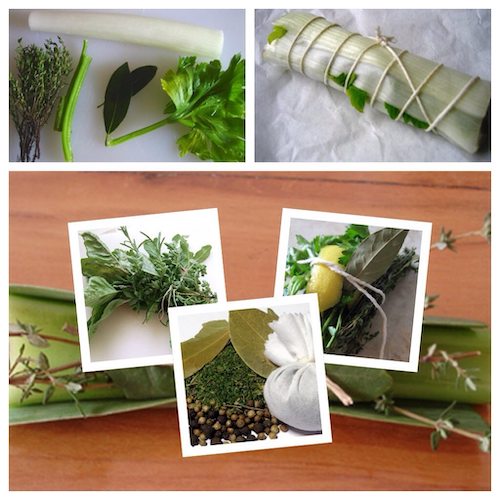
There are so many different ways to make a bouquet garni but the basic ingredients are the same. The three ingredients common to all of the bundles shown above are thyme, bay leaves and parsley. When a leek and celery are added, the bundle is often wrapped in the layers of the leek. I personally like this approach since the thyme often gets brittle and breaks during cooking. I have a bay laurel tree in my back yard, so I use fresh bay leaves. Depending on your tastes you can also add citrus rind. If you only have dried herbs, you can use a cheesecloth bag and add even more flavors like whole peppercorns, fresh garlic, or whatever you find appropriate. Other fresh or dried herbs can be added, like basil, rosemary, tarragon or even lavender.
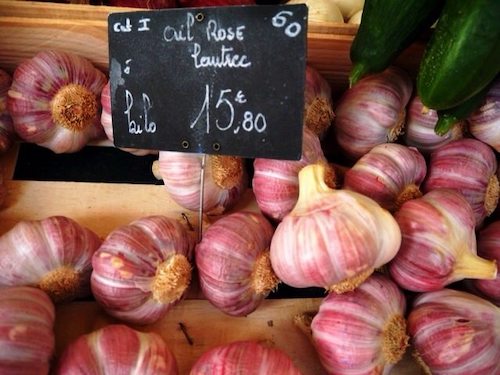
Garlic: Ail
This is Rose Lautrec garlic (ail de Rose Lautrec), grown exclusively in the Lautrec region of southern France (see my post). Garlic came originally from central Asia and has been used for at least 7000 years. Many modern crops are related to garlic including chives, leeks, onions and shallots. Two other significant garlic varities in France are Ail blanc de Lomagne and Ail de la Drôme. There really are differences in the taste of different types of garlic and specialty garlic is slowly becoming popular (Colin Boswell).
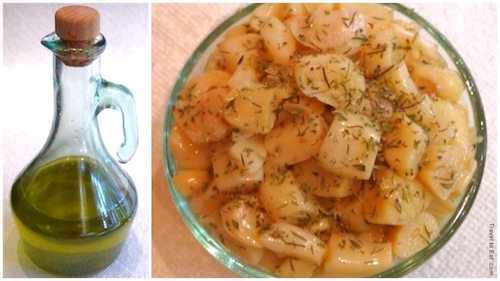
I personally love garlic and one of my favorite uses is “ail rôti au four” or oven roasted garlic. Here is a recipe for both garlic oil, “huile d’ail rôti”, and roasted garlic in one simple step. Cut the cloves in half, Put them in an ovenproof dish and pour in about a cup of olive oil with several sprigs of thyme. Cook at 300 degrees for about an hour. Strain the oil (it will last a month in an airtight container) and smush the garlic onto French bread, or dip French bread into the oil, or both, mmm. You can also use huile d’ail rôti with vinegar as a salad dressing. If you don’t care about the oil, take one or two cloves, cut them as shown, brush liberally with olive oil, add pepper Espelette (chilli pepper from the Basque area of France), place in tin foil and cook for an hour at 375. You will get a heavenly char and the garlic will be even softer.
Vegetables: Légumes
Artichoke: Artichaut
Asparagus: Asperge
Avocado: Avocat
Brussels Sprouts: Chou de Bruxelles
Cabbage: Chou
Cannelloni Beans: Haricot Blanc
Cranberry Beans: Haricot a Ecosser
Green Beans: Haricot Vert
Lima Bean: Haricot de Lima
Carrot: Carrotte
Cauliflower: Chou-Fleur
Celery: Céleri
Cucumber: Concombre
Eggplant: Aubergine
Lettuce: Laitue
Leek: Poireau
Onions: L’Oignon
Green Peas: Petites Pois
Sweet Pepper: Poivron
Potato: Pomme de Terre
Radish: Radis
Rhubarb: Rhubarbe
Shallot: Échalote
Tomato: Tomate
Zucchini: Courgette
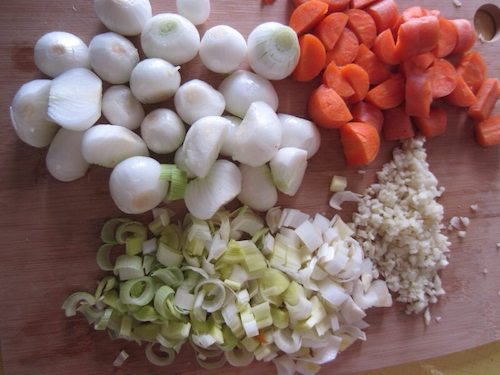
Mirepoix, the simple trinity of ordinary vegetables diced into even pieces, forms the foundation of a tremendous number of dishes. Knowing how to make and use mirepoix is one of the essentials of classical French cooking. A classical French mirepoix is onions, celery and carrots in a ratio of 2:1:1. Carrots, onions and celery may be everyday vegetables, but they are also aromatics, which means they enhance the natural flavors and aromas of foods. By cooking them slowly together, you’re releasing these flavors and their liquids and creating a base for the dish. It is important to have the dices about the same size for even cooking. Smaller cubes can be used for stock, bigger cubes for stew as seen in the above photo which I used to make coq au vin. I substituted garlic for celery and a combination of leeks and pearl onions for the onion.
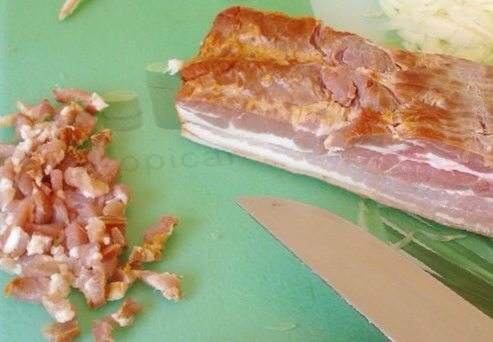
The French are very precise about their ratios, for instance the ratio of bones to mirepoix in making a soup stock is 10:1. If you are really interested in the ratios visit Quizlet for flash cards. A mirepoix may be prepared “au gras” (with meat) or “au maigre” (“lean”). Using my example of the coq au vin, the mirepoix was cooked with French petit salé, salt pork, and would be “au gras”. Petit salé is like Italian or Spanish lardo but more meaty. Different places base their mirepoix on preference and availability. The Cajun “holy trinity” is onions, celery and bell peppers. Spanish sofrito is a combination of tomatoes, onion and garlic cooked in olive oil instead of the Buerre (butter) used in France. Olive oil is used in most of the Mediterranean countries, including Italien soffrito which is a combination of shallots, leeks, garlic and other herbs like basil and oregano. Each combination gives a distinctive flavor to the countries cuisine.
I am going to finish this post with a short description of slicing and dicing French style. The secret is to make them all look the same with neat edges. For home use you can vary the size to something more practical for your needs and skill, but with a straight edge they will impress the neighbors. The rationale for all of this is to have the vegetables cook evenly, the best choices are firm vegetables like carrots, celery and potatoes. Although these techniques can be time consuming, they will also enhance the visual appeal of your food. All of these techniques require a very sharp knife (watch your fingers).
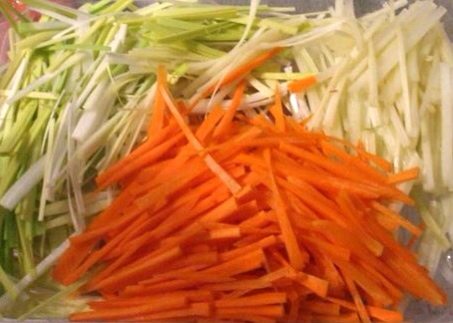
Julienne: A Julienne is a cut 1/8″ by 1/8″ by 3 inches, also called a matchstick. To make a Julienne cut with a knife, say a carrot, first cut it into 3″ lengths and square it off (you can eat the castoffs or use them in soup). Cut it into 1/8″ strips, pile the strips on top of each other and cut again into 1/8″ matchsticks. Voila, julienned carrots, it’s a lot harder than it sounds, easier to use a mandolin. Here is a list of the French names for “sticks”.
Batonnet = 1/2″ x 1/2″ x 3″
Allumette = 1/4″ x 1/4″ x 3″
Julienne = 1/8″ x 1/8″ x 3″
Fine Julienne = 1/16″ x 1/16″ x 3″
Brunoise: This is basically a technique to produce evenly cubed vegetables. Let’s begin with a few definitions:
Large dice (Carré)= 3/4″ cubed
Medium dice (Parmentier)= 1/2″ cubed
Small dice (Macédoine) = 1/4″ cubed
Brunoise = 1/8″ cubed
Fine Brunoise = 1/16” cubed
As you can see, a Brunoise dice is made by putting your julienned carrots together and cross-cutting horizontally into equal sided cubes. Easier to use a food processor but if you want to impress the neighbors, this is how to do it. The Paysanne is the less formal way to chop vegetables, you just cut them up into roughly equal sizes. This is the method for most home cooks, like me, but it is interesting and informative to see how the big chefs do it. In traditional formal French kitchens many chefs possess a small food-safe ruler and will randomly measure to check quality is maintained. Its a skill that takes years to develop and is highly respected in kitchens.
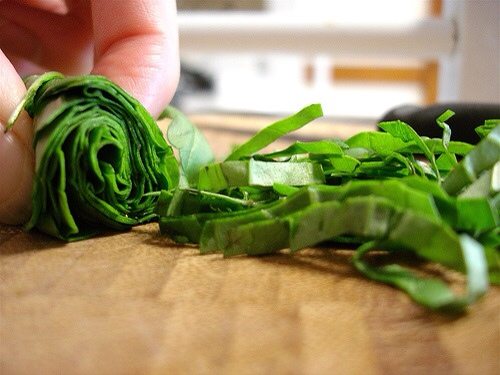
Chiffonade: This cutting technique is used on herbs or leafy vegetables. The result is long, thin strips that can vary in width from 1mm up to 1 inch. This is generally done by stacking the leaves on top of each other, rolling them tightly to form a tube, and then cutting across the rolled leaves with a sharp knife to produce fine ribbons. Rolling them can make it easier, but too big a roll will be harder. Its fine to roll up herbs such as basil, but not ideal for lettuce or anything you will serve raw as it may bruise them and the final result won’t be as crisp. Another less time consuming method for basil, parsley and other thin leaved plants is to ball them up in the palm of your hand and make fine cuts across the ball (on a cutting board, not your hand).

